
This is a tutorial on how to set up an effective and intuitive tram system with a call button system to bring the tram to you. Sometimes the basic functionality of the trams and rails just isn’t enough. But with some simple circuits, a tram system can be made that always brings the tram to you, and is expandable to great sizes, while allowing for complex networks of paths.
Comprehensive Guide to Tram System
Table of Contents
Table of Contents
- A list of all the different sections.
Endpoint Circuit
- A circuit that controls returning the tram with the call button.
Endpoint (x-axis)
- A station for the tram car, it is where a passenger can call the tram car and board or exit. This one is oriented to accept a tram car along the horizontal axis.
Endpoint (y-axis)
- A station for the tram car, it is where a passenger can call the tram car and board or exit. This one is oriented to accept a tram car along the vertical axis.
T-Junction (x-axis)
- This is the place where the rail splits into different directions, the tram car can move in any of them as you choose. This one is oriented so that the leg of the T is along the horizontal axis.
T-junction (y-axis)
- This is the place where the rail splits into different directions, the tram car can move in any of them as you choose. This one is oriented so that the leg of the T is along the vertical axis.
Vertical Hatch Rail
- When you have a vertical hatch with a rail, the timing of sensors to automatically control the opening and closing of the hatch for the tram can be tricky.
Endpoint Circuit
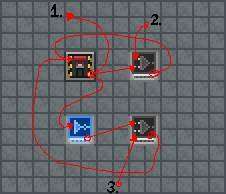
One of these circuits is needed for every endpoint in the tram system. Endpoint is the word used here for when the rail reaches a dead end. When you build an endpoint, build one of these circuits nearby. You will need:
- 1 small wall switch.
- 1 not gate.
- 2 and gates.
Arranging them as shown in the picture is not necessary and they are arranged that way for clarity. You can arrange them as best suits the space available and the aesthetics you want, but try to keep the small wall switch from being accessible because flipping it manually once the rail system is complete can cause minor problems. The arrows in the picture indicate what wires need to be attached and to where. Some arrows go to black numbers. These will be explained shortly. For the other arrows, they lead to locations where the wire from the start of the arrow needs to be attached in the place indicated by the arrow. As an example, the small wall switch output needs to be connected to each and gate in one place. The numbered items are as follows:
- The small wall switch needs to connect to all T-junction rail switches on rails leading to the endpoint for this small wall switch. A T-junction, as explained later, has rail switches on most rails leading away from the junction, and if a tram car will need to take a certain direction at a junction to get to the endpoint this small wall switch is for, then the small wall switch output should hook up to the rail switch on that direction of the junction.
- The rail sensor on the endpoint this upper and gate is for must connect to one of the and gate inputs.
- The tiny wall button above the endpoint that this lower and gate is for must connect to one of the and gate inputs.
Endpoint (x-axis)
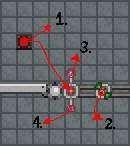
This is an endpoint, where the tram passenger can exit the tram, enter the tram, or call the tram to this endpoint using the tiny wall button at hand. It is oriented to accept a tram car along the horizontal axis, and if you build it so that all the components are mirrored across the y-axis, it will work in the opposite direction from the picture. You will need:
- 3 platforms.
- 1 tiny wall button.
- 1 rail bumper.
- 1 rail tram stop.
- 1 rail sensor.
- 2 rail pieces (and more to extend the rail to its next destination of course).
The tiny wall button connects to the center of the rail tram stop. The numbered items are as follows:
- The tiny wall button must connect to the corresponding endpoint circuit’s lower and gate on one input.
- The rail sensor must connect to the corresponding endpoint circuit’s upper and gate on one input.
- The rail tram stop’s upper antenna must connect to the lower antenna of all other rail tram stops connected immediately by rail, with no other tram stops in between. For example, let’s say you have a rail with three rail tram stops in a row on it. One is on the end, this will be the rail tram stop we are dealing with. The middle one is for a T-junction and the one on the far end is for another endpoint. For our current rail tram stop, its upper antenna must connect to the lower antenna of the T-junction, but not the lower antenna of the other endpoint since there is another rail tram stop between it and the current rail tram stop. Rail tram stops on endpoints only ever have to connect to one other rail tram stop, but a T-junction will connect to three.
- The rail tram stop’s lower antenna must connect to the upper antenna of all other rail tram stops connected immediately by rail, with no other tram stops in between. Similar to above.
Endpoint (y-axis)
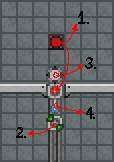
This is an endpoint, where the tram passenger can exit the tram, enter the tram, or call the tram to this endpoint using the tiny wall button at hand. It is oriented to accept a tram car along the vertical axis, and if you build it so that all the components are mirrored across the x-axis, it will work in the opposite direction from the picture. It is recommended that the tiny wall button in this case is moved to the side by about 4 tiles rather than being flipped to the bottom. You will need:
- 6 platforms.
- 1 tiny wall button.
- 1 rail bumper.
- 1 rail tram stop.
- 1 rail sensor.
- 3 rail pieces (and more to extend the rail to its next destination of course).
The tiny wall button connects to the center of the rail tram stop. The numbered items are as follows:
- The tiny wall button must connect to the corresponding endpoint circuit’s lower and gate on one input.
- The rail sensor must connect to the corresponding endpoint circuit’s upper and gate on one input.
- The rail tram stop’s upper antenna must connect to the lower antenna of all other rail tram stops connected immediately by rail, with no other tram stops in between. See previous section for an example.
- The rail tram stop’s lower antenna must connect to the upper antenna of all other rail tram stops connected immediately by rail, with no other tram stops in between. Similar to above.
T-Junction (x-axis)
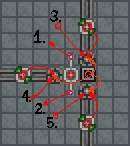
This is a place where three rails meet. The tram will stop at the center and allow the tram passenger to choose which direction to take using the directional controls. This one is oriented so that the leg of the T is along the horizontal axis. If you mirror it across the y-axis, it will work in the opposite direction from the image. You will need:
- 3 rail sensors.
- 3 rail switches.
- 1 scanner.
- 1 rail tram stop.
- 6 rail pieces (and more to connect the rail to the rest of the world).
The scanner is connected to all three rail switches, and each rail sensor is connected to the nearest rail switch. The numbered items are as follows:
- The rail tram stop’s upper antenna must connect to the lower antenna of all other rail tram stops connected immediately by rail, with no other tram stops in between. For example, let’s say you have two T-junctions and one endpoint reachable directly from this T-junction. All three have rail tram stops that you will have to connect this upper antenna to.
- The rail tram stop’s lower antenna must connect to the upper antenna of all other rail tram stops connected immediately by rail, with no other tram stops in between. Similar to above.
- This rail switch must be connected to the output of all small wall switches on endpoint circuits that lie ahead of this rail direction. For example, let’s say you have two endpoints that can be reached by taking this direction. There is a T-junction that separates the two rail paths somewhere in between. This rail switch must connect to the output of the small wall switch belonging to each endpoint’s circuit.
- This rail switch must be connected to the output of all small wall switches on endpoint circuits that lie ahead of this rail direction. Similar to above.
- This rail switch must be connected to the output of all small wall switches on endpoint circuits that lie ahead of this rail direction. Similar to above.
T-Junction (y-axis)
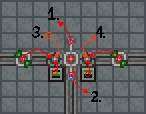
This is a place where three rails meet. The tram will stop at the center and allow the tram passenger to choose which direction to take using the directional controls. This one is oriented so that the leg of the T is along the vertical axis. If you mirror it across the x-axis, it will work in the opposite direction from the image. You will need:
- 2 rail sensors.
- 2 rail switches.
- 2 scanners.
- 1 rail tram stop.
- 7 rail pieces (and more to connect the rail to the rest of the world).
The rail switch on the left is connected to the scanner below it and the rail sensor to the left, and the rail switch on the right is connected to the scanner below it and the rail sensor to the right. The numbered items are as follows:
- The rail tram stop’s upper antenna must connect to the lower antenna of ALL other rail tram stops connected immediately by rail, with no other tram stops in between. See previous section for an example.
- The rail tram stop’s lower antenna must connect to the upper antenna of ALL other rail tram stops connected immediately by rail, with no other tram stops in between. Similar to above.
- This rail switch must be connected to the output of ALL small wall switches on endpoint circuits that lie ahead of this rail direction. See previous section for an example.
- This rail switch must be connected to the output of ALL small wall switches on endpoint circuits that lie ahead of this rail direction. Similar to above.
Vertical Hatch Rail

A vertical hatch with a rail can be tricky. Sensors need to be placed at a certain distance to keep the tram from colliding with a closed hatch. Luckily the picture here demonstrates the distances needed for the sensors. The upper sensor must have three segments of rail between it and the hatch. The lower sensor must have five segments of rail between it and the hatch.
Conclusion
Endpoints and T-junctions are not the only way to make rails meet. Endpoints have 1 direction, T-junctions have 3, but you can also do 2. Just have a single rail tram stop along your track and hook up its antennae to both surrounding rail tram stops as normal. If you want a junction with more than 3 directions, you have to make some combo of the others. The simplest example is the 4-way junction, of course. For one of these you make 4 T-junctions and connect the arms of each T in a circle, with the legs pointing outward (2 x-axis T-junctions and 2 y-axis T-junctions). Above 4 you can combine them in other ways.
If you’ve finished building your rail tram system, congratulations! Drop a rail tram car on the track and try it out! Board and exit the tram car, try calling the tram from various endpoints, etc.
Some pieces of advice:
- Make sure that there aren’t blocks in the way of the tram car. It has a path that needs to be kept clear of collision objects.
- If your tram doesn’t work even once you’ve finished it, you probably wired something up wrong. The bigger and more complicated your rail system the harder it is to figure out where and how many wiring mistakes you may have made.
- If your tram system is too large, waiting for the tram to arrive when you call it from all the way across the tram system can take a long time and is a real drag. Consider breaking up the tram system into multiple separate systems with their own tram cars.
I’m glad I was able to design a better tram system, because the base functionality demonstrated in the game’s space stations is not useful at larger scales. I hope you’ve enjoyed this guide and maybe even make a cool tram system for your space station, planet, or asteroid base!


Be the first to comment